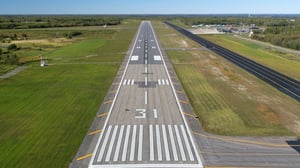Challenge
The International Falls-Koochiching County Airport Commission was faced with reconstructing the runway at Falls International Airport, the region's only commercial service runway and international Port of Entry, without interrupting its service. The existing bituminous runway had reached the end of its service life and required complete reconstruction.Solution
By partnering with SEH and completing a Triggering Event Master Plan (TEMP) before starting design, the Airport Commission was able to identify needs and opportunities, develop a thoughtful phasing plan, develop a funding strategy, and complete key stakeholder outreach.
Phased, multi-year approach
With the Master Plan in place, the team set the stage for a multi-year infrastructure renewal project broken down into three phases. The unique phasing approach included using the taxiway as a Part 139 Certified runway during construction of the critical center phase of reconstruction. This phasing allowed the airport to remain operational during reconstruction of the pavements while ensuring airfield safety. Each phase involved unique design elements and accomplishments.
- Phase 1, constructed in 2019 with a construction cost of approximately $3.7 million, included the reconstruction of the northern 1,000 ft. of Runway 13/31. This phase involved complicated construction phasing to maintain shortened runway operations, including the installation of temporary visual navigational aids for landing traffic and a new approach lighting system threshold bar. A fast-paced environmental assessment for phases 2 and 3 was also completed during Phase 1.
- Phase 2, constructed in 2020, had a construction cost of approximately $12.5 million. This phase focused on the reconstruction and widening of Taxiway A to prepare the taxiway to meet runway standards in Phase 3 and an apron expansion for additional large aircraft parking. This phase also included drainage improvements, AGIS (airports geographic information systems) instrument approach procedure development, new taxiway edge lighting, property acquisition, and the relocation of the National Weather Service’s Weather Balloon Launch facility.
- Phase 3, constructed in 2021, involved the reconstruction of 5,500 ft. of Runway 13/31, the critical center section of the runway. With a construction cost of approximately $14 million, this phase began with the three-day conversion of the parallel taxiway into temporary Runway 14/32, including a phased grading plan to transition the standard runway safety area from Runway 13/31 to Runway 14/32, installing temporary runway edge lighting, runway certification to Part 139 standards (commercial service), and publication of temporary instrument approach procedures to Runway 14/32. Once the temporary runway was operational, the center section of Runway 13/31 was reconstructed. This included new drain tile, drainage improvements, placement of the new pavement section, grading of the runway safety area, pavement markings, pavement grooving, and the installation of new electrical components including a state-of-the-art LED edge lighting system and new precision approach path indicators. After the center section of the runway construction was completed, Runway 13-31 opened and the temporary Runway 14-32 was transitioned back to a taxiway. This involved grading to Runway 13-31 standards, certification of Runway 13-31 pavement markings, grading and lighting, removal of Runway 14-32 markings, removal of Runway 14-32 edge lights, and replacement of the taxiway markings and edge lights.
Meaningful stakeholder engagement contributed to the success of this multi-phased project. Local businesses that routinely use the airport, such as Packaging Corporation of America, the airlines, and other airport users and tenants, were consulted to determine the adverse effects of closing the airport for up to three months during the construction of the critical center runway section. To document the impact on commercial service travelers, a survey effort was initiated as part of a project information station on both the secure and non-secure side of the terminal.
In addition, these phases involved extensive airline stakeholder engagement and collaboration with multiple lines of business across the Federal Aviation Administration (FAA), including the Airport District Office (ADO), Technical Operations, Engineering Services, and Flight Procedures. This coordination protected FAA-owned equipment during construction and created instrument approach procedures for a temporary runway. To ensure safety during the complex and challenging construction phasing, a Safety Risk Management (SRM) panel was conducted.
Using a collaborative approach and starting with the end in mind during project planning, the Airport Commission and SEH implemented an exceptional reconstruction project while keeping the airport open to commercial service and general aviation traffic throughout the busy summer months.
Project
Airport Runway and Taxiway Reconstruction
Location
City of International Falls, MN
Client
International Falls-Koochiching County Airport Commission
Features
- Extensive coordination with essential stakeholders, including the Dakota Minnesota Airport District Office, Great Lakes Region of the FAA, SkyWest Airlines, and Delta Air Lines
- Unique phasing approach during construction allowed the airport to preserve commercial service during the critical summer months
- $30 million overall project was completed under budget and on schedule
Services
- Airport planning and design
- Civil engineering
- Construction services
- Mechanical and electrical engineering
- Natural resources
- Structural engineering
- Water resources engineering
- Survey

.png?width=113&name=SEH_Logo_RGB%20(1).png)
